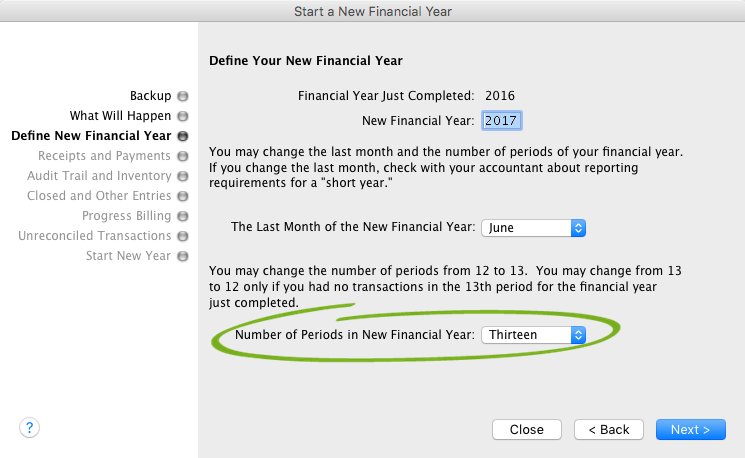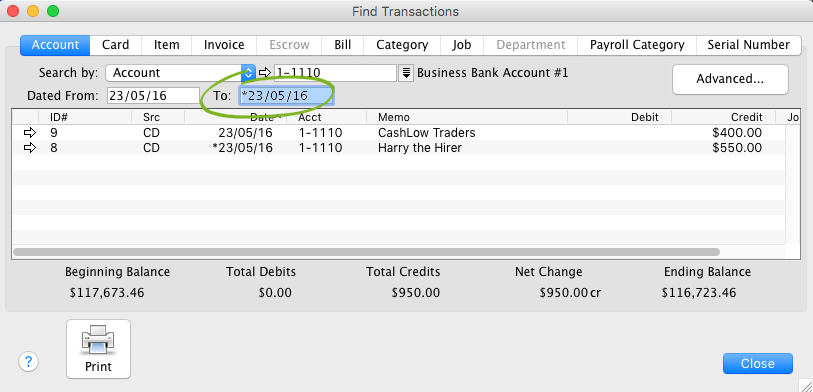- Created by admin, last modified by AdrianC on Sep 12, 2016
https://help.myob.com/wiki/x/gQec
ANSWER ID:9073
AccountEdge's 13th period provides a convenient method of dating certain transactions so they don't affect a particular reporting period.
This page answers some common questions about 13th period transactions.
In normal accounting practices, there are twelve reporting periods in a financial year. Each of these periods is represented by a calendar month, and is a defined chronological period.
The 13th period isn't an actual period of time; it's merely a 'placeholder' period that contains year-end adjustments. Transactions dated in the 13th period are done so with the intention of the transaction not affecting any of the twelve actual reporting periods.
Common business reports, such as the profit and loss report, base themselves on transactions dated within the report date range. It's not always practical to have a transaction influence one particular reporting period.
For example: A manufacturer's piece of machinery fails unexpectedly. The repair is expensive and will have an adverse affect for the particular month's reporting.
This type of expense could be dated in the 13th period, avoiding the expense being attributed directly to the affected month.
The 13th period is also commonly used for end of year adjustments such as prepayments and accruals.
The 13th period is an option when first setting up a company file. It is also an option when starting a new financial year. You can easily check if your company file is currently set up for 13 periods: Go to Setup and choose Company Information.
If the Accounting Periods is Twelve, you will need to wait till you start a new financial year before the 13th period can be activated.
To activate the 13th period when starting a new financial year:
- Go to the File menu and choose Start a New Year the choose Start a New Financial Year.
- Follow the on-screen steps until you get to the step shown here.

- Select Thirteen from the Number of Periods in New Financial Year drop down list.
With the thirteenth period activated in your company file, simply place an asterisk (*) in front of the transaction's date in the Date field.
Here's an example Spend Money transaction dated in the 13th period, identified by the asterisk in front of the date in the Date field.

- Record Journal Entry
- Spend Money
- Receive Money
- Prepare Bank Deposit
- Bank Register (Spend Money and Receive Money transactions)
- Transfer Inventory
- Count Inventory
- Auto-Build Inventory
13th period transactions can be reported by themselves, or they can be included with the conventionally dated transactions on a YTD basis.
When filtering reports and transaction listing, you will need to be mindful that the 13th period transactions won't be included if an asterisk isn't used in the report Date field. 13th period transactions can be reported by themselves, or they can be included with the conventionally dated transactions. When viewing 13th period transactions along with conventional dated ones they will only be shown as part of a YTD value.
Reporting transactions in both the conventional twelve periods AND the 13th period will reflect 13th period entries in the YTD balance regardless of the 'To' date selected. It will not reflect partial months/partial years of 13th period entries.
The 13th period cannot be reported as part of normal daily, weekly or monthly P&L and can only be reported on its own or as part of a YTD value.
The below examples show the effects of the 13th period when filtering transactions in the Find Transactions Window. For the purposes of this comparison, two Spend Money payments have been entered for the same date, but one is dated in the 13th period.
Example 1: Reporting transactions in both the conventional twelve periods AND the thirteenth period. Enter an asterisk in the To date field ONLY, for example From 01/07/2012 To *29/07/2012.

Example 2: Reporting transactions within the conventional twelve periods. DO NOT enter an asterisk in either of the Date fields, for example From 01/07/2012 To 29/07/2012.

Example 3: Reporting transactions within the thirteenth period ONLY. Enter an asterisk in BOTH the From and To Date fields, for example From *01/07/2012 To *29/07/2012.

